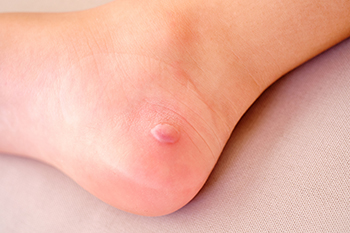Foot Blisters May Be Linked to Diabetes

Diabetic foot blisters are a concerning complication for people managing diabetes, primarily due to nerve damage and poor circulation. Friction blisters often occur in diabetics with neuropathy, where the lack of pain sensation leads to unnoticed skin rubbing and blister formation. One type of blister specific to diabetes can appear spontaneously and without inflammation, while posing a high risk for secondary infections. Certain fungal infections also contribute to blister formation, especially in warm, moist areas, such as between the toes. A podiatrist plays an essential role in managing these complications by providing regular foot exams and identifying early signs of blister formation. This foot doctor also can educate patients on proper foot care practices to prevent blisters, such as choosing suitable footwear and maintaining good hygiene. For fungal infections, a podiatrist can prescribe effective antifungal medications and monitor the healing process. If you are experiencing diabetic foot blisters, it is suggested that you make an appointment with a podiatrist for an exam and treatment.
Blisters are prone to making everyday activities extremely uncomfortable. If your feet are hurting, contact one of our podiatrists of Carolina Foot & Ankle Specialists. Our doctors can provide the care you need to keep you pain-free and on your feet.
Foot Blisters
Foot blisters develop as a result of constantly wearing tight or ill-fitting footwear. This happens due to the constant rubbing from the shoe, which can often lead to pain.
What Are Foot Blisters?
A foot blister is a small fluid-filled pocket that forms on the upper-most layer of the skin. Blisters are filled with clear fluid and can lead to blood drainage or pus if the area becomes infected.
How Do Blisters Form?
Blisters on the feet are often the result of constant friction of skin and material, usually by shoe rubbing. Walking in sandals, boots, or shoes that don’t fit properly for long periods of time can result in a blister. Having consistent foot moisture and humidity can easily lead to blister formation.
Prevention & Treatment
It is important to properly care for the affected area in order to prevent infection and ease the pain. Do not lance the blister and use a Band-Aid to provide pain relief. Also, be sure to keep your feet dry and wear proper fitting shoes. If you see blood or pus in a blister, seek assistance from a podiatrist.
If you have any questions, please feel free to contact our offices located in Mount Pleasant and Charleston, SC . We offer the newest diagnostic and treatment technologies for all your foot care needs.


